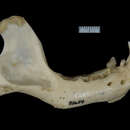en
names in breadcrumbs


Perception Channels: tactile ; chemical
With a fairly wide distribution and large populations, these animals seem unlikely to become endangered soon.
IUCN Red List of Threatened Species: least concern
They become very tame when caught young and are clean and easy to keep.
This versatile, omnivorous mongoose exploits a wide range of swampy conditions where many kinds of food are found. Freshwater crabs, mussels and snails are major foods; reptiles and birds and their eggs, large insects and their larvae, millipedes and various fruits also constitute part of the diet. These mongooses investigate every hole or crevice along river banks often finding hidden crabs or frogs. When they are looking for food in ponds they patiently and systematically work their hands through the mud and water. While foraging, the mongoose often holds its head out of the water. The sifting motion of the hands is rapid and continous until food is located. Once an item is found, it is pulled out of the water and may be taken relatively slowly into the mouth. If the prey strugggles, it is killed with a bite. Any hard objects such as mussels, crabs and eggs are hurled down with considerable force to break open the shell.
The Marsh Mongoose is widely distributed over all the better-watered parts of Africa.
Biogeographic Regions: ethiopian (Native )
Mongooses range from sea level up to 2,500 meters, but they prefer swampy vegetation bordering rivers and lakes. There are records of mongooses inhabiting hilly regions where there is little water and no aquatic fauna to feed on. Marsh mongooses are an important member of the small community of animals specially adapted to Papyrus swamps. Due to the deoxygenated water of the Papyrus swamp, only air breathing fish, frogs, insect larvae, snails, and mongooses inhabit the region.
Terrestrial Biomes: savanna or grassland ; forest ; rainforest ; scrub forest
Aquatic Biomes: lakes and ponds; rivers and streams
Average lifespan
Status: captivity: 17.0 years.
Average lifespan
Status: captivity: 17.4 years.
This medium-sized dark-brown animal is one of the more highly specialized mongooses. The neck, body and tail are covered with thick, shaggy fur while the fur on the hands and feet is short and sleek. The hand are extremely soft and sensitive and the thumb functions as a passive prop, enhancing the animal's purchase on a slippery surface. The premolar teeth are stout and used for crushing hard foods and the lower canines are particularly well-developed.
Range mass: 2.5 to 4.1 kg.
Other Physical Features: endothermic ; bilateral symmetry
Little is known about their sexual behavior, but it is known that they breed twice a year, once in the middle of the dry season and once in the rains. The female prepares a nest of dry grass in a hole. If there are no holes available in swampy areas, the young are raised on a nest of reeds, grass, and sticks . Up to three young per litter have been recorded. Sometimes a second adult also accompanies the family. The young usually are weaned and depart from their birthplace in a few months.
Key Reproductive Features: gonochoric/gonochoristic/dioecious (sexes separate); sexual
Average birth mass: 100 g.
Average gestation period: 76 days.
Average number of offspring: 2.
Average age at sexual or reproductive maturity (male)
Sex: male: 255 days.